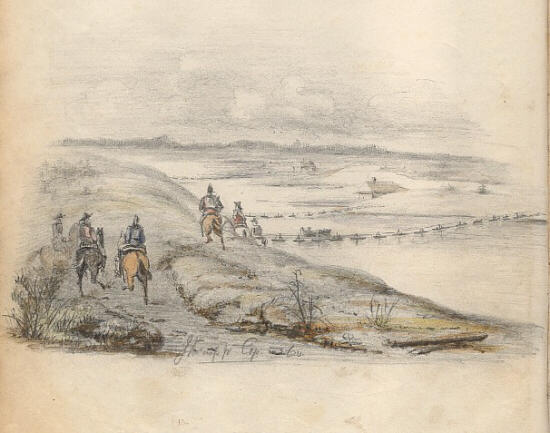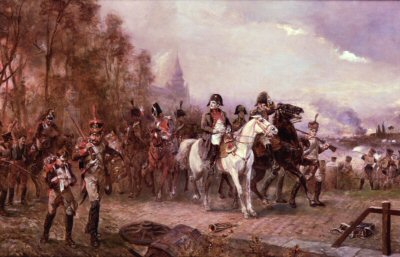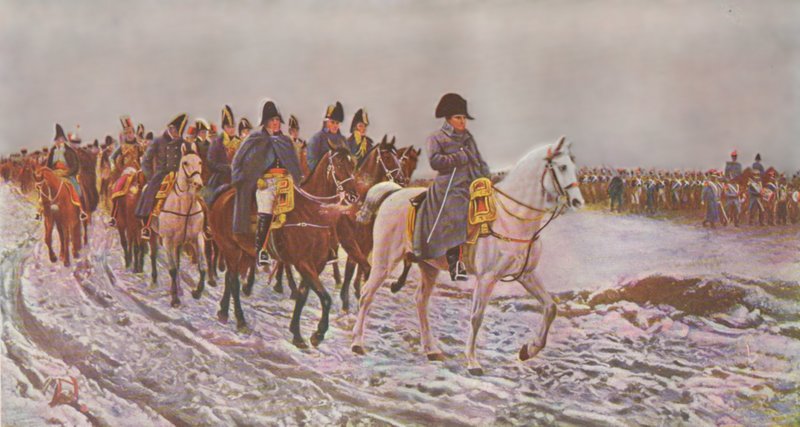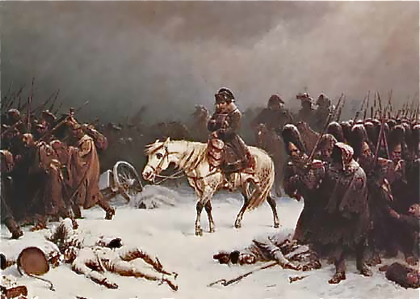The
Effects of
Climate and Terrain on Napoleon's Invasion of Russia in 1812
By
Michael McCarty
By
1812, Napoleon was an unstoppable force, controlling most of
continental
Europe. His decision to invade Russia is
considered one of the greatest mistakes in military history. Raising a force of Frenchmen and allies
numbering over 600,000, his plan was to sweep in and out of Russia in a
matter
of months. By sheer numbers and training
the odds were in his favor, but due to unforeseen weather conditions
and the
ruggedness of the terrain over which his army was required to travel
Napoleon
returned home less than six months later with less than five percent of
his
original army.
Napoleon's
reasoning for invading Russia was more complicated than simply wanting
to
conquer it. Czar Alexander had ended
trade with France following the annexation of Western
Galacia into the Grand Duchy of Warsaw.
The Czar feared that this would be a launching place for a
French
invasion of Russia. This end of trade
deprived France of the raw materials that they had been receiving from
Russia
and forced Napoleon's hand. If trade
could not be reestablished, he had to invade and take it by force.
Czar
Alexander's forces were a formidable opponent in themselves; the
country's army
outnumbered Napoleon's invasion force, though it was spread over the
expanse of
the Russian countryside. In order to
defend his country, Alexander employed the same technique used to
defeat
Charles XII of Sweden in 1709: drawing
the invading force into the Russian interior and allowing the brutal,
sweeping
winter to weaken the army. With a tough
Russian army that was used to severe weather and adverse terrain and
nearly
infinite space into which he could retreat, Alexander could simply make
his
army into a non-entity, keeping far enough ahead of an invading force
that he
was never forced into pitched battle and letting Russia herself be the
enemy. He was also familiar with the
Napoleonic army's practice of living off the inhabitants and land while
on the
march. In order to prevent this, he
employed a scorched-earth policy. By
destroying all crops and vegetation, he cut off supplies for not only
the men,
but also for the large amounts of horses necessary for carrying
supplies,
artillery, and for supporting the large French cavalry.
Burning entire villages and rural structures
deprived the Grande Army of usable shelter from the Russian climate.
For
successful takeover, Napoleon knew that he must be in and out of Russia
before
winter. His large Grande Army would meet
the lesser Russian force early on and overwhelm it in one single,
decisive
battle. Napoleon assumed that Russian
patriotism would cause the Imperial army to stand and fight, allowing
him a
swift and complete victory due to his army's superior numbers,
training, and
armaments. In order to support a massive
military invasion into a country that was less equipped to supply an
army on
the move, Napoleon stockpiled provisions along the Russian border in
Poland and
Germany. His plans were well-laid and
complete. By all appearances, the Grande
Army was prepared to sweep into Russia, conquer, and be back in Europe
before
it could be trapped by the harsh Russian winter.
 The
first main obstacle of Russian geography that Napoleon faced was the
crossing
of the Niemen River. Napoleon's plan for
crossing the river was incredibly elaborate, anticipating what he
assumed would
be heavy resistance by the Russians on the other side.
The site for crossing the Niemen was chosen
by Napoleon himself and would place his main occupying force directly
into
Lithuania. In order to move the large
number of men, horses, artillery, and wagons to the eastern bank, he
ordered
three pontoon bridges to be constructed.
In the days following their completion, 449,000 French coalition
forces
and 1,146 artillery pieces marched slowly over the three bridges as
Napoleon
watched from a hill. In the following
days Napoleon would have three more bridges built across the river in
order to
facilitate faster movement of troops.
Upon reaching the other side, the forces met little resistance. Unbeknown to Napoleon, the main Russian force
had retreated to Vilna and only a small number of Russian troops were
left to
observe the army's movements.
The
first main obstacle of Russian geography that Napoleon faced was the
crossing
of the Niemen River. Napoleon's plan for
crossing the river was incredibly elaborate, anticipating what he
assumed would
be heavy resistance by the Russians on the other side.
The site for crossing the Niemen was chosen
by Napoleon himself and would place his main occupying force directly
into
Lithuania. In order to move the large
number of men, horses, artillery, and wagons to the eastern bank, he
ordered
three pontoon bridges to be constructed.
In the days following their completion, 449,000 French coalition
forces
and 1,146 artillery pieces marched slowly over the three bridges as
Napoleon
watched from a hill. In the following
days Napoleon would have three more bridges built across the river in
order to
facilitate faster movement of troops.
Upon reaching the other side, the forces met little resistance. Unbeknown to Napoleon, the main Russian force
had retreated to Vilna and only a small number of Russian troops were
left to
observe the army's movements.
Upon
entering Lithuania, the Grande Army began to experience a small
sampling of the
hardships that would become increasingly crippling as the army advanced
towards
Vilna. Frequent thunderstorms turned the
soft ground into unforgiving mud. While
infantry and cavalry were less affected by the unstable ground,
artillery and
supply wagons fell farther and farther behind the main army. Men found their rations severely diminished
and the expected forty-day rations that had initially been provided
were
nowhere in sight. The men turned to
foraging and pillaging from the local inhabitants to supplement their
diets. This had been the the custom for
the forces in densely-populated continental Europe, but in Russia, the
population density proved lower per square mile and foraging was
impossible due
to the 'scorched earth' policy that the Russians employed.
By burning all crops and anything else useful
that they could not carry with them as they retreated eastward, the
Russians
foiled French attempts to augment their supplies as their own rations
dwindled.
Troops
also suffered from heavy dehydration in the intense heat of the Russian
summer. Over-exerted by the forced
marches through soggy ground, soldiers filled their canteens from the
stagnant
rainwater that collected in the army's tracks.
This led to thousands of cases of dysentery and other
water-borne
diseases. The Grande Army found some
relief in Vilna, but a disappointed Napoleon decided to push on and
follow the
Russians, who had moved farther east.
Other than a few small skirmishes, no large decisive battle had
yet
taken place, much to Napoleon's chagrin.
Moving farther eastward, the army exchanged wet weather for the dry, dusty conditions of Russia's
summer, leaving men with a complete lack of water.
The men found themselves praying for the same
weather that had cost them so many of their supply wagons mere months
before.
By
August, the number of the main force, originally 400,000, had plummeted
to
185,000. This reduction in size was due
to an astounding 100,000 casualties and deserters.
The remainder had been detached along the way
to secure a line of retreat. Napoleon
and his generals recognized approach of an early winter and
contemplated
camping for the winter at Vitebsk.
Napoleon had not yet at this point considered retreat as an
possible
course of action and saw pressing forward as his army's only option,
still
hoping for a victory before winter hit.
 As
the seasons began to noticeably change, Napoleon and the Grande Army
finally
saw their first full-scale engagement.
Up until this point, the Grande Army had been advancing
virtually
unopposed, meeting with Russian forces only during occasional
harassments from
Cossack calvary. The Russian forces were
able to stay sufficiently far ahead of the French, trading space for
time as
they retreated increasingly farther into their country.
Drawing closer to Moscow, however, the
Russians finally made a stand. The
Battle of Borodino would be the only large battle during the entire
campaign. By that time, the French had
lost so many men that the forces were almost equal in manpower. Although better trained, armed and organized,
weakened and demoralized Grande Army's first and only battle was
completely
indecisive. After a day of fighting and
heavy casualties on both sides, the Russians retreated from the battle
and from
Moscow, leaving the path open for the French.
As
the seasons began to noticeably change, Napoleon and the Grande Army
finally
saw their first full-scale engagement.
Up until this point, the Grande Army had been advancing
virtually
unopposed, meeting with Russian forces only during occasional
harassments from
Cossack calvary. The Russian forces were
able to stay sufficiently far ahead of the French, trading space for
time as
they retreated increasingly farther into their country.
Drawing closer to Moscow, however, the
Russians finally made a stand. The
Battle of Borodino would be the only large battle during the entire
campaign. By that time, the French had
lost so many men that the forces were almost equal in manpower. Although better trained, armed and organized,
weakened and demoralized Grande Army's first and only battle was
completely
indecisive. After a day of fighting and
heavy casualties on both sides, the Russians retreated from the battle
and from
Moscow, leaving the path open for the French.
The
remnants of the Grande Army entered Moscow on September 14, only to
find a
major portion of the city on fire and completely stripped of all
supplies. The
remaining inhabitants, those unable or unwilling to leave, hid from the
army in
the Kremlin and provided no help. Even
the small population of Frenchmen living in Moscow wanted nothing to do
with
Napoleon's forces. Four-fifths of Moscow
burned to the ground while the army found what relief they could in the
city
for just over a month.
In
Moscow, Napoleon was faced with a difficult decision of choosing
whether to
stay in Moscow or cut his losses and retreat out of Russia. If the army were to stay in Moscow, they
would be able to take shelter for the winter months and stood a chance
of
surviving the elements inside the city.
However, remaining in Moscow would have made them a stationary
target
for the remaining Russian army to harass, and Napoleon risked a losing
battle
against the Russians' yet unused resources from the east.
If the army were to retreat westward,
carrying with it what supplies they could procure in Moscow, they hoped to take a more southwesterly route than
the road they had marched on their advance and supplement their
supplies along
the way. With a quick retreat, they
might be able to escape the worst of the harsh winter weather. Hurrying his decision was the looming winter,
but he waited with hope of a peace treaty from the Czar.
By October 18th, Napoleon realize
that the Czar was only promising a peace treaty in order to keep the
Grande
Army longer into winter and ordered an evacuation of the city and
retreat. According to Harold Winters in Battling the Elements, each soldier was
given fifteen rations of flour as the
army left Moscow. Despite the fact that
Napoleon had chosen the option which relied on a swift withdrawal, the
army carried
with it the plunder it had secured in Moscow, which only served to slow
the
rate of march.

Originally
planning to take a more southerly route back toward Vilna, Napoleon
hoped to
capture Russian supply depots and to avoid the barren road, stripped
and
destroyed by two armies, that he had traveled on his advance. Their retreat was cut off by the Russian
general Mikhail Kutuzov at Maloyaroslavets, forcing them back toward
the
sterile Smolensk road of their eastward journey. Now
retracing their steps, they were caught
unprepared for the early first hard freeze of the winter on October 28,
followed by the first snow nine days later.
At first the presence of frozen ground made moving wagons and
artillery
pieces easier but the advent of snow soon made it impossible and the
pieces
were either abandoned or burnt for firewood.
As the snow grew deeper and deeper, the army struggled to find
grass for
its dwindling population of horses and some entire cavalry units were
demoted
to units of foot.
The
army set its sights on the city of Smolensk, hoping that it would
provide
much-needed shelter and supplies. This
brought some glimmer of hope to the demoralized troops, but constant
attacks by
Russian soldiers kept morale low as well as thinning out their already
reduced
numbers. Finally reaching Smolensk on the
13th of November, the weary soldiers found it to be the
exact
opposite of that for which they hoped.
Russian canon fire to the west of the city forced the evacuation
of the
army, leaving 17,000 sick and injured men in makeshift hospitals set up
in the
city's burnt-out buildings.
The
army, now numbering 20,000, continued westward and was met by 30,000
reserves
from Polotsk. According to Charles
Joseph Minard's cartogram from 1861, the average day temperature was
now around
twenty below zero. The effects of the
cold caused many men to succumb to hypothermia while marching. The dead and dying were buried in the snow
after their fellow soldiers took their clothes in an attempt to stay
warm.
The
pursuing army met up with the French force at the Berezina River, 150
miles
west of Smolensk, on the 28th of November.
The French hastily built pontoon bridges in
order to cross the ice-clogged but unfrozen river, effectively creating
a
bottleneck. The Russian army pressed
them from behind, forcing them to the river.
Those that made it to the bridges were not guaranteed safety; if
a man
fell, he would be trampled. Those who
could not cross at a bridge were pushed into the river.
Two-thirds of the French force died that day,
with fewer than 20,000 men arriving more or less safely on the western
bank of
the Berezina. Once on the other side of
the river, Napoleon left his army for Paris, leaving Marshall Joachin
Murat in
command.
 The
beginning of December brought temperatures under thirty below zero. Five thousand men died of cold alone in a
week's time as a now unpursued army trudged across western Russia. A regiment of 15,000 men that had been
stationed in Vilna made the three-day march to meet the army, but only
3,000
arrived. Some sources say that in the
final ten days' march out of Russia, 18,000 men died from the cold. The Russians were not spared losses to the
brutally low temperatures, either.
Mikhail Kutuzov's army of 100,000 at the Berezina River dwindled
to
1,700 by the time it reached Vilna.
The
beginning of December brought temperatures under thirty below zero. Five thousand men died of cold alone in a
week's time as a now unpursued army trudged across western Russia. A regiment of 15,000 men that had been
stationed in Vilna made the three-day march to meet the army, but only
3,000
arrived. Some sources say that in the
final ten days' march out of Russia, 18,000 men died from the cold. The Russians were not spared losses to the
brutally low temperatures, either.
Mikhail Kutuzov's army of 100,000 at the Berezina River dwindled
to
1,700 by the time it reached Vilna.
It
is estimated that as many as 552,000 men were left dead, captured, or
deserted
in Russia. Even though many were lost in
countless skirmishes as well as lesser battles and formal warfare, the
majority
of the losses can be credited to the extreme weather of Russia. Crippled by unforgiving terrain, Napoleon's
army found itself insufficiently supplied as it was forced to leave
supply
wagons and artillery behind due to muddy or nonexistent roads as well
as deep
snow. The wet weather of midsummer
brought about disease; it was followed by dry, hot weather that brought
about
dehydration. The vastness of the
landscape foiled the army's prior habits—the practice of provisioning
off land
and inhabitants worked well in densely-populated Europe.
In sparse Russia, however, the scorched and
inhospitable land proved unable to provision a marching army. Topping this all was the beginning of winter,
where temperatures plummeted to a deadly cold that affected both the
Russian and
French armies. The remnants of the Grande
Army returned to Vilna by December 7th, where just another
few days'
march would take them out of Russia before the frigid weather of
January and
February. Napoleon's plan had succeeded,
then, in at the very least one aspect:
his army left Russia before the hardest part of winter.
Copywrite
2009 Michael McCarty
Apendix
Biblography
External Links
 The
first main obstacle of Russian geography that Napoleon faced was the
crossing
of the Niemen River. Napoleon's plan for
crossing the river was incredibly elaborate, anticipating what he
assumed would
be heavy resistance by the Russians on the other side.
The site for crossing the Niemen was chosen
by Napoleon himself and would place his main occupying force directly
into
Lithuania. In order to move the large
number of men, horses, artillery, and wagons to the eastern bank, he
ordered
three pontoon bridges to be constructed.
In the days following their completion, 449,000 French coalition
forces
and 1,146 artillery pieces marched slowly over the three bridges as
Napoleon
watched from a hill. In the following
days Napoleon would have three more bridges built across the river in
order to
facilitate faster movement of troops.
Upon reaching the other side, the forces met little resistance. Unbeknown to Napoleon, the main Russian force
had retreated to Vilna and only a small number of Russian troops were
left to
observe the army's movements.
The
first main obstacle of Russian geography that Napoleon faced was the
crossing
of the Niemen River. Napoleon's plan for
crossing the river was incredibly elaborate, anticipating what he
assumed would
be heavy resistance by the Russians on the other side.
The site for crossing the Niemen was chosen
by Napoleon himself and would place his main occupying force directly
into
Lithuania. In order to move the large
number of men, horses, artillery, and wagons to the eastern bank, he
ordered
three pontoon bridges to be constructed.
In the days following their completion, 449,000 French coalition
forces
and 1,146 artillery pieces marched slowly over the three bridges as
Napoleon
watched from a hill. In the following
days Napoleon would have three more bridges built across the river in
order to
facilitate faster movement of troops.
Upon reaching the other side, the forces met little resistance. Unbeknown to Napoleon, the main Russian force
had retreated to Vilna and only a small number of Russian troops were
left to
observe the army's movements. 

